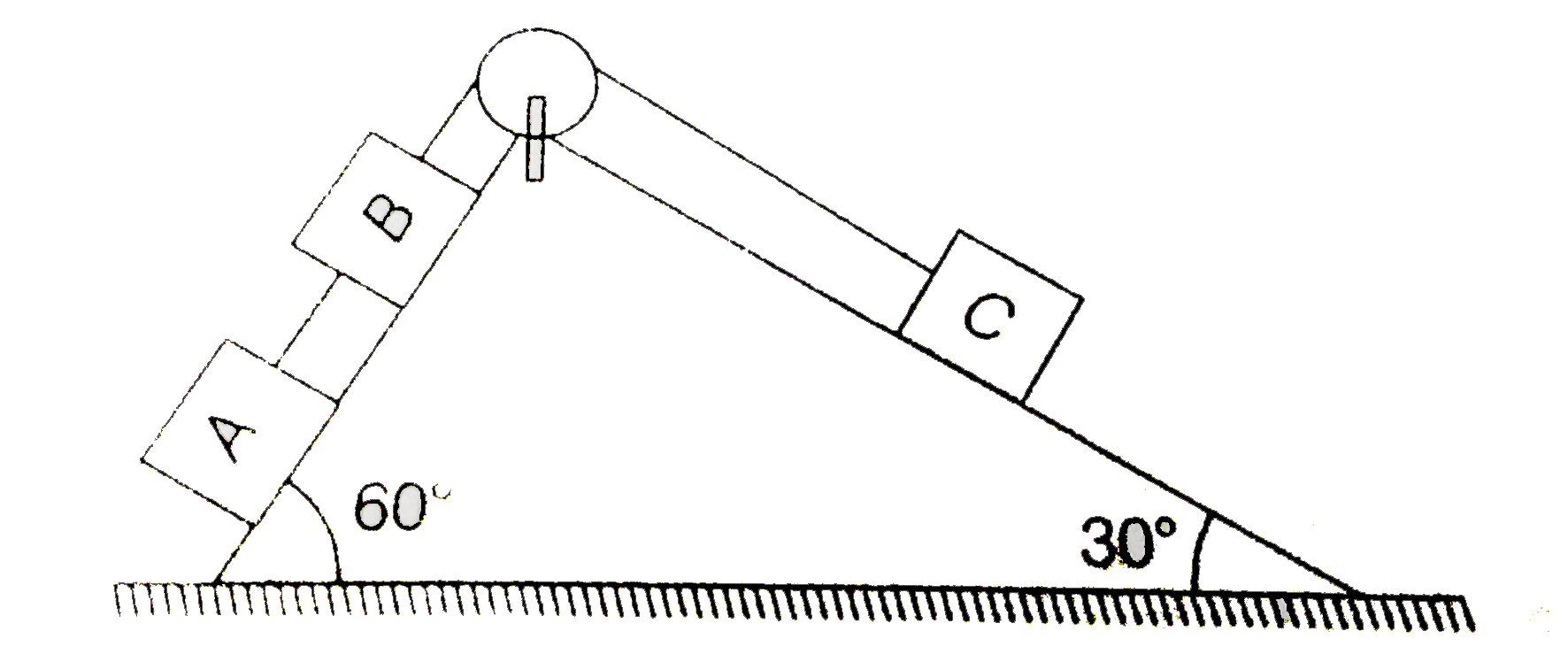In the adjacent figure, mass of A, B and C are 1 kg , 3 kg and 2 kg, respectively. Find

(a) the acceleration of the system, and
(b) tensions in the string .
Neglect friction. (g=10ms−2)
(a) IN this case net pulling force
= mAgsin60∘+mBgsin60∘−mCgsin30∘
=(MA+mB)gsin60∘−mCgsin30∘
=(1+3)×10×√32−2×10×12
=20√3−10=20×1.732−10=24.64N
Total mass being pulled = 1+ 3+2= 6 kg

∴ Acceleration of the system a =24.646=4.1m/s2
(b) For the tension T1 in the string between A and B, mAgsin60∘−T1=(mA)(a)∴T1=mAgsin60∘−mAa=mA(gsin60∘−a)
⇒T1=(1)(10×√32−4.1)=4.56N
For the tension T2 in the string between B and C.
T2−mCgsin30∘=mCa
⇒T2=mC(a+gsin30∘)=2[4.1+10(12)]=18.2N

Topper's Solved these Questions
- BOOK - ALLENCHAPTER - NEWTON'S LAWS OF MOTION & FRICTIONEXERCISE - EXERCISE (S-1)26videos
NEWTON'S LAWS OF MOTION & FRICTION
- BOOK - ALLENCHAPTER - NEWTON'S LAWS OF MOTION & FRICTIONEXERCISE - EXERCISE (S-2)9videos
NEWTON'S LAWS OF MOTION & FRICTION
- BOOK - ALLENCHAPTER - MOTION IN A PALNEEXERCISE - SOLVED EXAMPLE28videos
MOTION IN A PALNE
- BOOK - ALLENCHAPTER - NEWTONS LAWS OF MOTIONEXERCISE - EXERCISE-III28videos
NEWTONS LAWS OF MOTION
Similar Questions
In the adjacent fig, masses of A, B and C are 1 kg, 3kg and 2kg respectively. Find a) the acceleration of the system b) tension in the string (g=10m/s2)
 View Solution
View SolutionIf coeffiecient of friction between the block of mass 2kg and table is 0.4 then out acceleration of the system and tension in the string. (g=10m/s2)
 View Solution
View Solution
Knowledge Check
- Question 1 - Select One
In the adjacent figure, masses of A,B and C are 1kg,3kg and 2kg respectively. Find
(a) the acceleration of the system and
(b) tension in the strings.
Neglect friction.(g=10m/s2)
 A2.1m/s2 , T1=4.56NB4.1m/s2 , T1=2.56NC4.1m/s2 , T1=4.56ND4.1m/s2 , T1=14.56N
A2.1m/s2 , T1=4.56NB4.1m/s2 , T1=2.56NC4.1m/s2 , T1=4.56ND4.1m/s2 , T1=14.56N - Question 2 - Select One
As shown in figure A, B and C are 1 kg, 3 kg and 2 kg respectively. The acceleration of the system is -
 A5ms−2B4.11ms−2C4ms−2D5.11ms−2
A5ms−2B4.11ms−2C4ms−2D5.11ms−2 - Question 3 - Select One
Two block of mass 4 kg and 2 kg are attached by an inextensible light string as shown in figure. Both the blocks are pulled vertically upwards by a force F=120N

Find
(a) the acceleration of the blocks,
(b) tension in the string. (Take g=10ms−2)A10, 40B12, 40C20, 40D40, 35
In the above example, if two blocks have masses 1kg and 2kg respectively then find their acceleration and tension in different string.
View SolutionIf masses of the blocks A and B shown in figure-2.204 (a) and 2.204(b) are 10kg and 5kg respectively, find the acceleration of the two masses. Assume all pulleys and strings are ideal. (Take g=9.8ms2)
 View Solution
View SolutionIn the arrangement shown in Figure, mA=2kg and mB=1kg. String is light and inextensible. Find the acceleration of centre of mass of both the blocks. Neglect friction everywhere.
 View Solution
View SolutionTwo blocks of mass 2 kg and 5 kg are connected by an ideal string passing over a pulley. The block of mass 2 kg is free to slide on a surface inclined at an angle of 30∘ with the horizontal whereas 5 kg block hangs freely. Find the acceleration of the system and the tension in the string. Given μ=0.30.
View SolutionIn the figure-2.205 shown in blocks A, B and C has masses mA=5kg,mB=5kg and mC=10kg respectively, find the acceleration of the three blocks. Assume all pulleys and strings are ideal. (Take g=10m/s2)
 View Solution
View Solution

